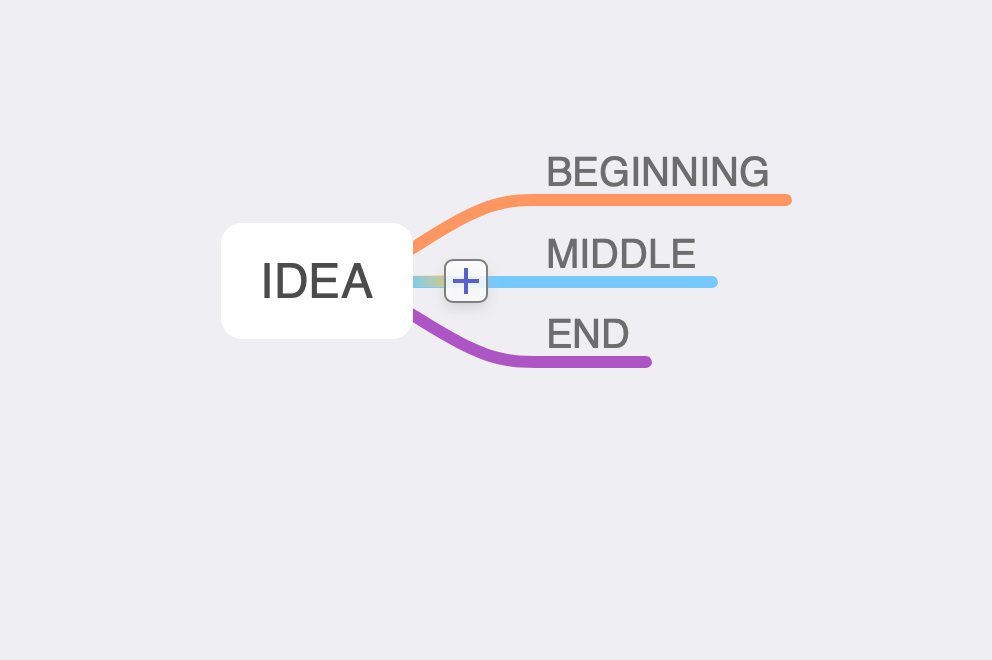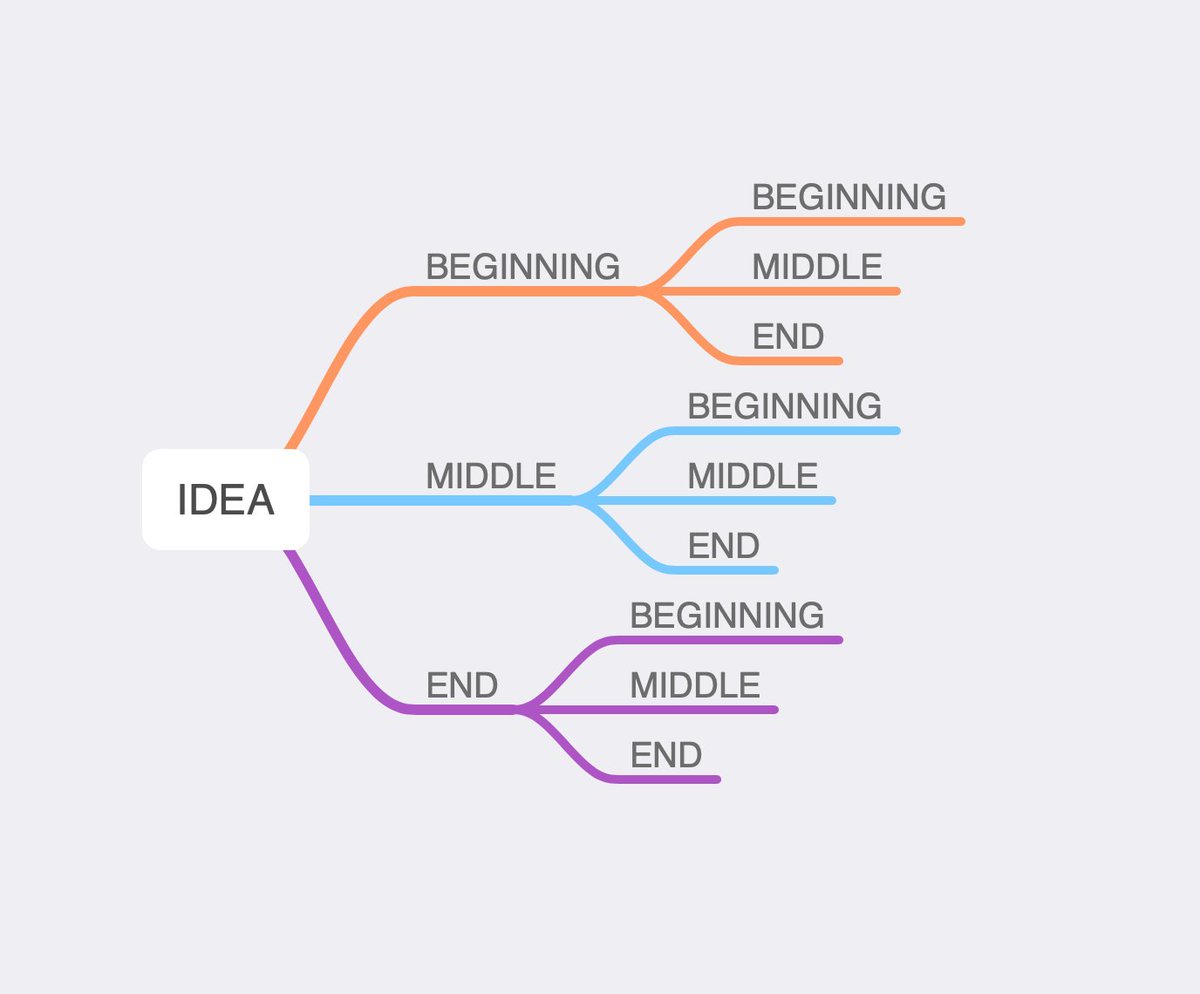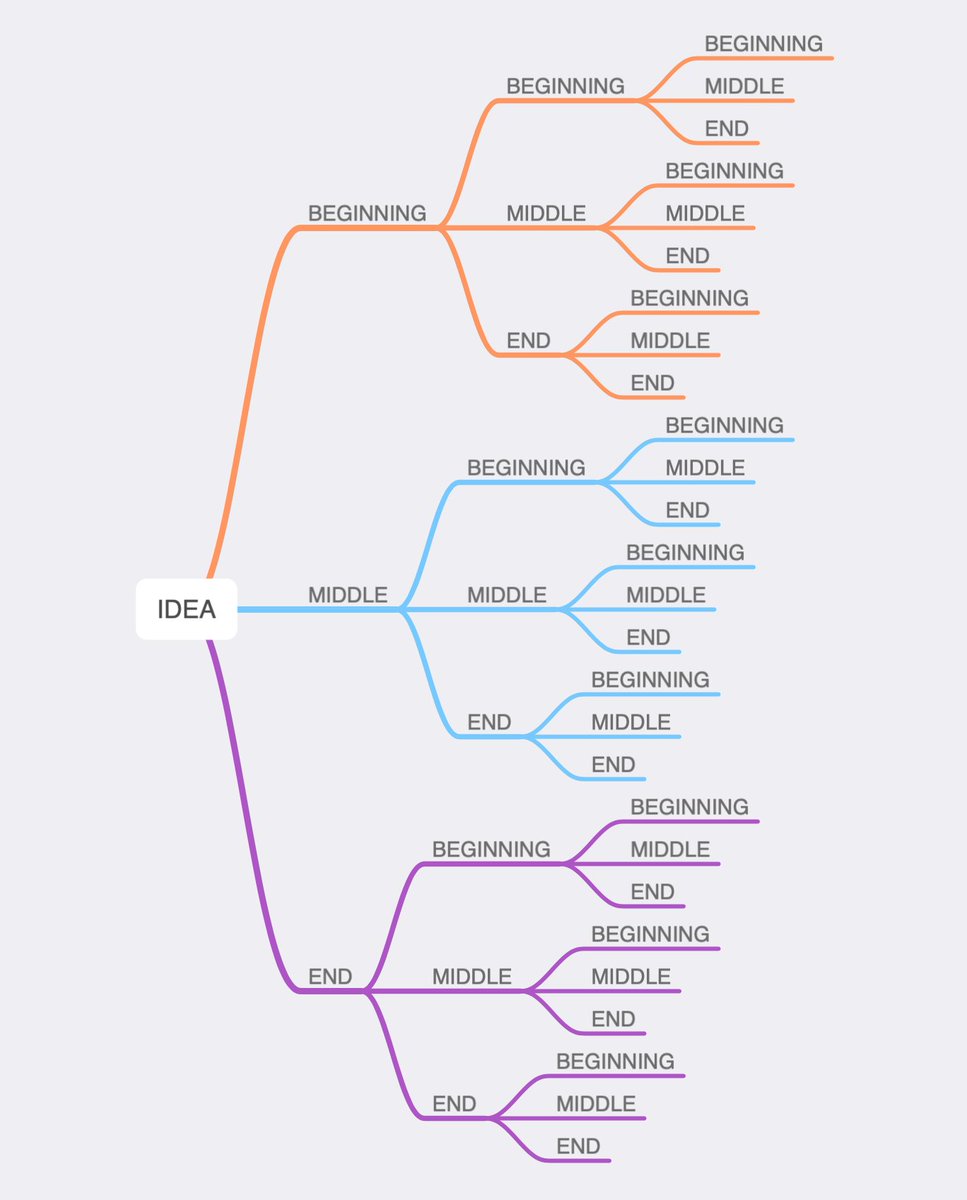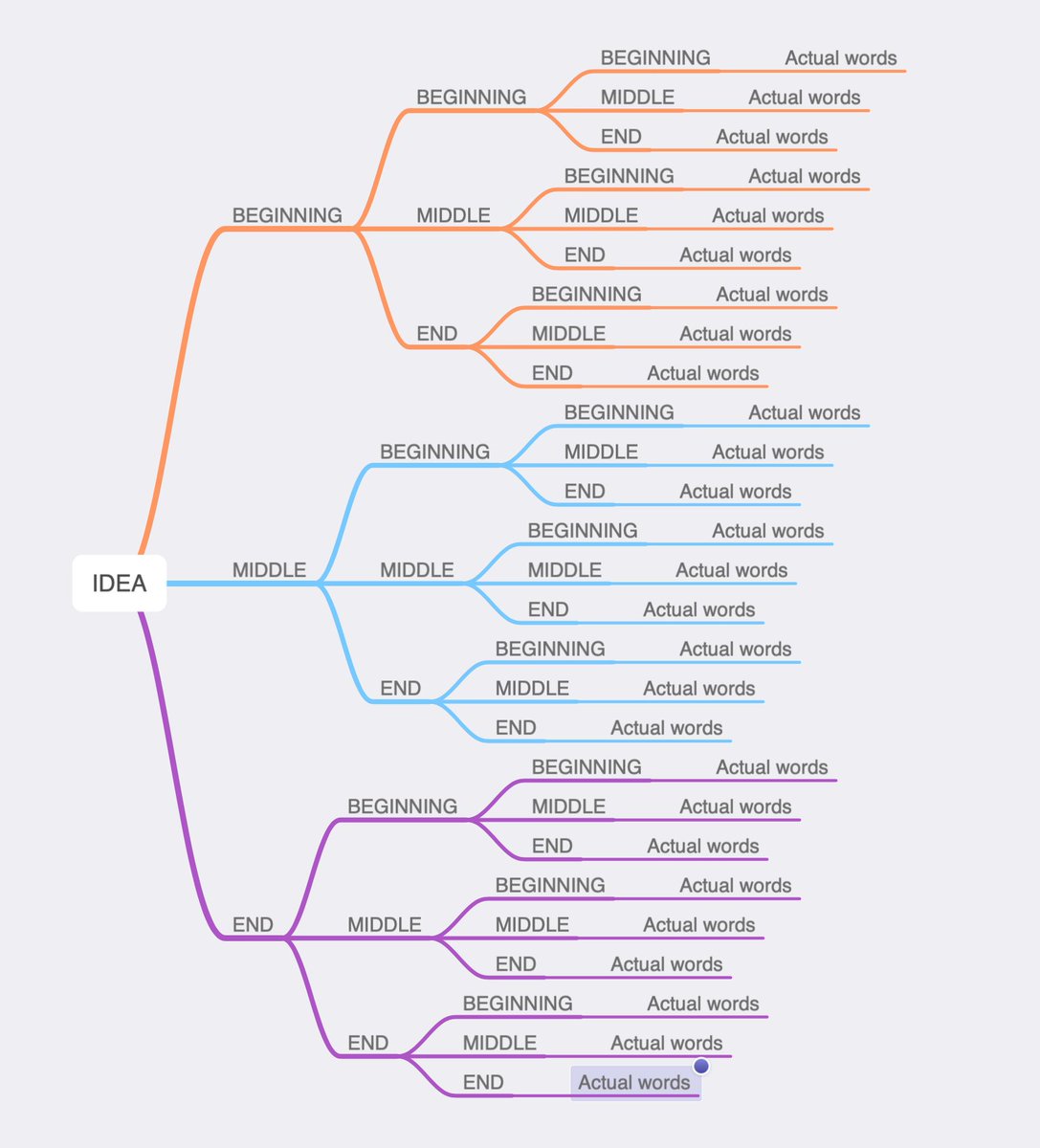1/ As promised, here's my One Simple Trick for writing anything. It's a trick that works for me. It may or may not work for you. It's not the only way of writing, and it's not even the only way I write.
2/ The One Simple Trick (I'll abbreviate to OST) isn't anything new, but it's a very specific way of doing something old.
3/ The motivation comes from two observations about writing: first, that writers will do ANYTHING to avoid actually writing, and second that the two most important words you ever write are THE END.
4/ The OST deals with these two things simultaneously by
a) postponing the actual writing - the final words on the page - for as long as possible
b) ensuring that you always, literally from the first minute, at some level of granularity, have a completed and improvable draft
a) postponing the actual writing - the final words on the page - for as long as possible
b) ensuring that you always, literally from the first minute, at some level of granularity, have a completed and improvable draft
5/ a) is important because it frees you to write badly. Because you aren't writing The Actual Words, you can stay loose, improvise, change, just splatter paint on the canvas
b) is important because the method is guaranteed to terminate.
b) is important because the method is guaranteed to terminate.
6/ If you follow this process you WILL finish whatever it is you're writing.
7/ The OST I'm going to describe is for writing something from scratch but it's trivial to adapt it to revising or analysing something you or someone else has already written - something I do all the time when adapting novels for the screen, for example.
8/ (Bear with me, we're getting there, I promise)
9/ Where this comes from: years ago I was a computer programmer and learned something called 'structured programming'. The OST is a variation of that. Maybe we can call it #structuredwriting.
10/ It's a version of outlining, which many writers hate, but it's a very particular version which, at least for me, makes the whole process far more straightforward and enjoyable.
11/ Okay, I'm almost done with the throat-clearing part. Last thing to say is that one benefit of the process is that you should never again find yourself staring at a blank page wondering what you should be writing today.
12/ All right. Lets GO. Here is my one simple trick to write anything:
13/ STEP ONE:
Write your idea in a single, brutally short sentence.
(I'm assuming you have an idea. If you don't have an idea, come back when you have one).
Example: A SPACE OPERA
Guess what? You already have an improvable, complete draft. I'm not even jokin.
Write your idea in a single, brutally short sentence.
(I'm assuming you have an idea. If you don't have an idea, come back when you have one).
Example: A SPACE OPERA
Guess what? You already have an improvable, complete draft. I'm not even jokin.
14/ STEP TWO:
Expand the sentence in Step One into three brutally short sentences, which describe the Beginning, Middle and End (BME) of whatever it is you're writing.
Expand the sentence in Step One into three brutally short sentences, which describe the Beginning, Middle and End (BME) of whatever it is you're writing.
15/ Let's just pause for a moment and be more specific about what I mean by BME. Presumably something changes in your story (I'll try to deal with non-narrative and non-linear documents down the line - it's fairly straightforward).
16/ So
Beginning: what things are like before they change
Middle: how things change
End: what things are like after they change
Beginning: what things are like before they change
Middle: how things change
End: what things are like after they change
17/ Example of Step 2:
B: A BOY'S FAMILY ARE KILLED BY AN EVIL EMPIRE
M: HE JOINS THE REBELS
E: TOGETHER THEY DEFEAT THE EMPIRE
B: A BOY'S FAMILY ARE KILLED BY AN EVIL EMPIRE
M: HE JOINS THE REBELS
E: TOGETHER THEY DEFEAT THE EMPIRE
18/ Hey, guess what? You just improved your draft. And it's still complete. And you still haven't had to actually, you know, *write write* anything.
STEP THREE:
Take each of the sentences in Step Two and break them into three brutally short sentences.
STEP THREE:
Take each of the sentences in Step Two and break them into three brutally short sentences.
19/ Use exactly the same process as you did in Step 2.
How things start
How they change
here they end up.
STEP FOUR:
You've guessed it. Keep doing this, working your way down through different levels of granularity.
How things start
How they change
here they end up.
STEP FOUR:
You've guessed it. Keep doing this, working your way down through different levels of granularity.
20/ For example, in screenwriting, you work your way down through
LOGLINE
ACTS
SEQUENCES
SCENES
BEATS
But there may be intervening levels, for example sub-acts and sub-sequences.
LOGLINE
ACTS
SEQUENCES
SCENES
BEATS
But there may be intervening levels, for example sub-acts and sub-sequences.
21/ The key thing is ALWAYS to work in groups of three -- Beginning, Middle, End.
22/ You can do this at absolutely all levels of granularity, from the very top, down to scenes, beats and even individual pieces of dialog.
23/ Now obviously at a certain point you will start writing The Actual Words, and I will leave that to you. But you will now have a complete roadmap. Every day you will begin writing knowing where you start and where you need to end up.
24/ And you always from Day 1 have an improvable, complete draft.
You absolutely don't have to write in order: I will often just pick a key scene or chapter I want to write and let it rip.
You absolutely don't have to write in order: I will often just pick a key scene or chapter I want to write and let it rip.
25/ Also, you're free to fuck around with your roadmap as you go. One of the beauties of this process is that it's REALLY easy to restructure (or refactor, as developers call it) your project.
26/ Another way of using this method is to take each of your characters or plotlines and write out their stories in BME format independent of the others.
27/ Then once you've done that, you slot each of their BMEs into your overall BME.
28/ You can also, if you're brave, write out the BME of you story and then start moving the pieces around to make a non-linear narrative, confident in the fact that the whole thing makes actual sense.
29/ You can also use BME to delineate character arcs or articulate a big dialog scene.
30/ Okay, I need a coffee now. At some point I'll describe how I flip all of this into non-narrative documents like pitches or papers.
32/ This is using @mindnode, which I like because it's so visual, but at some point I'll transition into (say) @ScrivenerApp, Word, @fadeinsoftware , @evernote or something else.
33/ If you're using Scrivener it can get a bit tricky because it likes to nudge you into parts/chapters/scenes before you're ready, so It can be worth NOT using the Manuscript folder to do your OST/BME but create a new one instead then transfer into the Manuscript folder later.
34/ I will often start in @mindnode, transfer into a regular text editor to linearise it and convert to a list of scenes, then drop that into @fadein to do The Actual Words. If I get stuck I will often pop back out into @mindnode to figure it out, using the same method.
35/ Another way of thinking about this is as a version of the classic Three Act Structure - but drilling the idea all the way down.
36/ Or as @fredine reminded me, it's the difference between specifying and implementing. By keeping the ideas abstract and postponing the writing/implementation of them you stay agile.
37/ But as @fredine also points out, sometimes you want to work from the bottom up. Maybe there's a scene or a piece of dialog that just needs to get written. Do it, and then slot it into the structure wherever it needs to go.
38/ This is not part of the One Simple Trick, but it is for me, and that is as @bjorke puts it, 'no zero days'. IOW it doesn't matter how much or how little paint you put on the canvas on any particular working day, or how good or bad it is. But you do something.
39/ Some days it might be ten words. Some days it might be five thousand. But over time they will average out to a particular rate of forward progress, which is different for everyone, but very reassuring to see settle into groove.
40/ If you choose to use something like @ScrivenerApp then by creating your own template and chunking your document into bite sized pieces ('scenes' in Scrivener) but organized into a tree-like structure that corresponds to your BME outline...
41/ Then it becomes extremely easy to play around with structure. The shorter your chunks are the easier it is to refactor things. If anyone's interested I can post a Scrivener template that gives you a starting point for this.

 Read on Twitter
Read on Twitter





